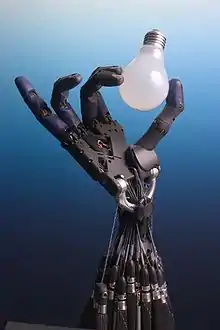Smartdust
Smartdust[1] is a system of many tiny microelectromechanical systems (MEMS) such as sensors, robots, or other devices, that can detect, for example, light, temperature, vibration, magnetism, or chemicals. They are usually operated on a computer network wirelessly and are distributed over some area to perform tasks, usually sensing through radio-frequency identification. Without an antenna of much greater size the range of tiny smart dust communication devices is measured in a few millimeters and they may be vulnerable to electromagnetic disablement and destruction by microwave exposure.
Design and engineering
The concepts for Smart Dust emerged from a workshop at RAND in 1992 and a series of DARPA ISAT studies in the mid-1990s due to the potential military applications of the technology.[2] The work was strongly influenced by work at UCLA and the University of Michigan during that period, as well as science fiction authors Stanislaw Lem (in novels The Invincible in 1964 and Peace on Earth in 1985), Neal Stephenson and Vernor Vinge. The first public presentation of the concept by that name was at the American Vacuum Society meeting in Anaheim in 1996.
A Smart Dust research proposal[3] was presented to DARPA written by Kristofer S. J. Pister, Joe Kahn, and Bernhard Boser, all from the University of California, Berkeley, in 1997. The proposal, to build wireless sensor nodes with a volume of one cubic millimeter, was selected for funding in 1998. The project led to a working mote smaller than a grain of rice,[4] and larger "COTS Dust" devices kicked off the TinyOS effort at Berkeley.
The concept was later expanded upon by Kris Pister in 2001.[5] A recent review discusses various techniques to take smartdust in sensor networks beyond millimeter dimensions to the micrometre level.[6]
The Ultra-Fast Systems component of the Nanoelectronics Research Centre at the University of Glasgow is a founding member of a large international consortium which is developing a related concept: smart specks.[7]
Smart Dust entered the Gartner Hype Cycle on Emerging Technologies in 2003,[8] and returned in 2013 as the most speculative entrant.[9]
See also
- Claytronics
- Dust Networks, Inc.
- Grey goo
- Mesh networking
- Nanotechnology
- Neural dust
- Prey (novel), a 2002 science fiction thriller by Michael Crichton about nanorobots which attack in swarms.
- Programmable matter
- RFID
- Self-reconfiguring modular robotics
- The Diamond Age, a 1995 science fiction novel by Neal Stephenson that mentions the use of dust for surveillance.
- The Invincible, a 1964 science fiction novel with intrigue centered on self-configuring microrobotic swarms.
- TinyOS
- Ubiquitous computing
- Utility fog
- Wireless sensor network
References
- More than Meets the eye. PC Mag. Mar 12, 2002. Page 30.
- Rosenthal, Marshal M. "Gamebits: Digital Tricks". Games. Issue 160 (Vol 24, #3). Pg.6. May 2000.
- "Smart Dust: BAA97-43 Proposal Abstract, POC: Kristofer S.J. Pister" (PDF). berkeley.edu. Retrieved 19 April 2018.
- "An autonomous 16 mm/sup 3/ solar-powered node for distributed wireless sensor networks - IEEE Conference Publication". doi:10.1109/ICSENS.2002.1037346. S2CID 17152548. Cite journal requires
|journal=(help) - "CiteSeerX". psu.edu. Retrieved 19 April 2018.
- Makin, Simon. ""Neural Dust" Could Enable a Fitbit for the Nervous System". scientificamerican.com. Retrieved 19 April 2018.
- Smart Dust for Space Exploration
- "2003 Gartner Hype Cycle on emerging technologies". Gartner. Retrieved 20 August 2016.
- "2013 Gartner Hype Cycle on emerging technologies". Gartner. Retrieved 14 September 2015.
External links
- How stuff works: motes
- Open source mote designs and TinyOS operating system from UC Berkeley
- Rethinking The Internet of Things Nature driven view of M2M cloud communications based on lightweight chirp devices.
- UC Berkeley Smart Dust Project
- Info about smart dust communications
- Sailor research group at UCSD
- SpeckNet research groups based in Scotland
- Web of Sensors "In the wilds of the San Jacinto Mountains, along a steep canyon, scientists are turning 30 acres [121,000 m2] of pines and hardwoods in California into a futuristic vision of environmental study. They are linking up more than 100 tiny sensors, robots, cameras and computers, which are beginning to paint an unusually detailed portrait of this lush world, home to more than 30 rare and endangered species. Much of the instrumentation is wireless. Devices the size of a deck of cards — known as motes, after dust motes..."
- Technologies to watch: motes
- Molecular shuttle power: Smart dust biosensors may be smaller than a grain of sand but they have big potential – an Instant Insight from the Royal Society of Chemistry
- http://www.betabatt.com/ Betavoltaic batteries from 2.5 micrometre cubed upwards, 10 to 30-year lifespan.

